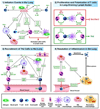Re-defining the unique roles for eosinophils in allergic respiratory inflammation
- PMID: 24961290
- PMCID: PMC4148640
- DOI: 10.1111/cea.12358
Re-defining the unique roles for eosinophils in allergic respiratory inflammation
Abstract
The role of eosinophils in the progression and resolution of allergic respiratory inflammation is poorly defined despite the commonality of their presence and in some cases their use as a biomarker for disease severity and/or symptom control. However, this ambiguity belies the wealth of insights that have recently been gained through the use of eosinophil-deficient/attenuated strains of mice that have demonstrated novel immunoregulatory and remodelling/repair functions for these cells in the lung following allergen provocation. Specifically, studies of eosinophil-deficient mice suggest that eosinophils contribute to events occurring in the lungs following allergen provocation at several key moments: (i) the initiating phase of events leading to Th2-polarized pulmonary inflammation, (ii) the suppression Th1/Th17 pathways in lung-draining lymph nodes, (iii) the recruitment of effector Th2 T cells to the lung, and finally, (iv) mechanisms of inflammatory resolution that re-establish pulmonary homoeostasis. These suggested functions have recently been confirmed and expanded upon using allergen provocation of an inducible eosinophil-deficient strain of mice (iPHIL) that demonstrated an eosinophil-dependent mechanism(s) leading to Th2 dominated immune responses in the presence of eosinophils in contrast to neutrophilic as well as mixed Th1/Th17/Th2 variant phenotypes in the absence of eosinophils. These findings highlighted that eosinophils are not exclusively downstream mediators controlled by T cells, dendritic cells (DC) and/or innate lymphocytic cells (ILC2). Instead, eosinophils appear to be more aptly described as significant contributors in complex interrelated pathways that lead to pulmonary inflammation and subsequently promote resolution and the re-establishment of homoeostatic baseline. In this review, we summarize and put into the context the evolving hypotheses that are now expanding our understanding of the roles eosinophils likely have in the lung following allergen provocation.
© 2014 John Wiley & Sons Ltd.
Conflict of interest statement
The authors have no conflict of interest to declare.
Figures

References
-
- Kumar RK, Herbert C, Foster PS. The "classical" ovalbumin challenge model of asthma in mice. Curr Drug Targets. 2008;9:485–494. - PubMed
-
- Martin TR, Gerard NP, Galli SJ, Drazen JM. Pulmonary responses to bronchoconstrictor agonists in the mouse. J Appl Physiol. 1988;64:2318–2323. - PubMed
-
- Molfino NA, Gossage D, Kolbeck R, Parker JM, Geba GP. Molecular and clinical rationale for therapeutic targeting of interleukin-5 and its receptor. Clin Exp Allergy. 2012;42:712–737. - PubMed
-
- Kung TT, Stelts DM, Zurcher JA, Adams GK, Egan RW, Kreutner W, et al. Involvement of IL-5 in a murine model of allergic pulmonary inflammation - prophylactic and therapeutic effect of an anti-IL-5 antibody. Am J Respir Cell Mol Biol. 1995;13:360–365. - PubMed
Publication types
MeSH terms
Substances
Grants and funding
LinkOut - more resources
Full Text Sources
Other Literature Sources

